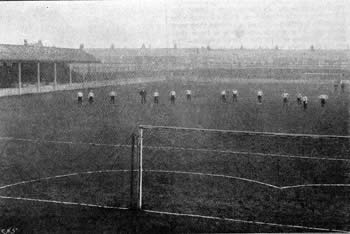newcastle roaD
1886 to 1898
Sunderland players line up across the Newcastle Road half way line The move to Newcastle Road would have far reaching consequences for the Football Club. It would be the venue for their entry into the Football League in 1890, mainly as a result of the 7 v 2 thrashing of Aston Villa on 5 April 1890. We recorded some mammoth victories here recording double figure scores on several occasions. The ground stretched along Crozier Street to Eglington Street North. Netherburn Road and Newlington Court were built over it. A high wall surrounded much of the ground. It had a grandstand. Sunderland favoured attacking the top end or Hood Street, facing the sun. It is a sign of the times that 2 of the Sunderland players were each paid 5 shillings (about 25 pence) to tar the fencing and clubhouse (roof); the latter had been bought for £2.50. The pitch was massive, some 120 x 75 yards, much bigger than Roker Park. The land was owned by the Thompson sisters, who charged the football club £15 per annum in rent. So impressed were they by their new tenants that they refunded this sum in the first year. In the close season the football club let the ground out for grazing, charging £1.50. By now the rent had doubled to £30. Mainly supporters employed at the Thompson’s North Sands yard built the stand on the North side. The football club’s headquarters became the Royal Hotel on North Bridge Street, some half a mile from the Newcastle Road ground. The players would change at the hotel and travel onwards for the home matches, arriving by brake. Later on in our tenancy the football club used tents to change in, until a final solution was arrived at, they purchased number 37 Ellerslie Terrace, over the road from the ground. This became the club’s office and committee meetings were held there. The house next door was also bought and this became a billiards and card room for the players. “The Team” changed here and walked over the road into the ground!! In 1889 a clubhouse was built, the ground admittance was increased to 1 shilling (about 5p). It was now the best stadium in the North East and boasted a capacity of some 15,000. Sunderland’s first ever Football League game was played at Newcastle Road and ended in a 2 v 3 defeat by Burnley on 13 September 1890. However the club had played prior to that match in various friendly and local cup games the first being against Birtley on 10 April 1886. The stadium recorded the highest ever attendance at an English football ground in January 1891 when 21,000 spectators witnessed the first round FA cup-tie against Everton. People sat on the roof of the stand. Perhaps the grounds most famous representation is in the Hemy painting of 1894/95, which portrays Sunderland in action against Aston Villa. It is alleged to be the oldest painting of an Association football match anywhere in the world and of course it now hangs in the main reception area of the Stadium of Light. In July 1896 the old club was wound up and Sunderland became a limited liability company. The rent was now £100 per annum. The last league match at Newcastle Road was on 23 April 1898 when The Black Cats routed Nottingham Forest, the English Cup holders, 4 v 0. James Chalmers scoring the final goal. The final match Sunderland played, as main tenants, at the location was against Gateshead NER on 9 April 1898. As a postscript to the story of Newcastle Road it is worth noting that in the 1960’s Ellerslie Terrace was demolished and a car sales business took it’s place. From Newcastle Road Sunderland AFC moved onto one of Britain’s most famous sporting venues; Roker Park.
|

